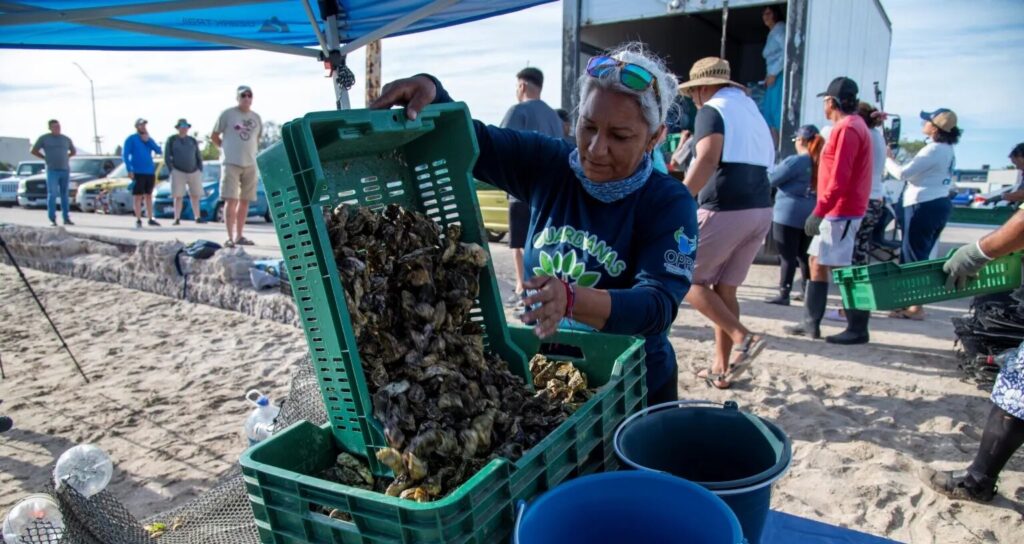Between 2015 and 2017, an invasive ascidian species (tunicate) caused the mortality of 80 percent of the population of the ax callus who was in the recovery stage at the Ensenada de La Paz. This provoked among men and women of El ManglitoThe company's goal was to encourage those who had their sights set on the exploitation of this species to think of different alternatives.
This is how a group of 12 women who were cleaning and restoring the mangrove swamp at El CochalitoThe first four of them decided to start a project to cultivate oysters.
With the accompaniment of NOS Sustainable Northwest ACThey conceptualized and designed the project, planned it and now, after a long training and learning process, they are implementing it. Recently (end of May), they have just received their first batch of 150 thousand oysters (small oysters between 3-5 cm), with the objective of cultivating them and taking them to the commercialization stage.
The oysters they received come from Blue SunThe reception was attended by the 12 Guardians, young people from the community, some members of OPRENOS staff, NOS personnel, citizen volunteers and volunteers from different partner organizations, who responded to the call made by the Guardianas team.

In a coordinated and organized manner, the oysters were placed in oyster bags at defined densities, and from there they were taken to the cultivation areas, where the oyster lines and beds where they will remain during cultivation were previously installed.
Results expected in two to six months
For this project, Las Guardianas relies on the permission of Aquaculture Development OPRE, since they are also members of that organization, but they would like to be able to have their own aquaculture permit in the near future.
They are using two techniques for cultivation: suspended sacks in line and oyster beds (also known as the French technique). The next step is to maintain the oysters, take them to commercial size and document the process, with the objective of generating a profitable economic activity.
For the time being, with this lot they received, they expect that, within two to six months, most of them will reach the commercialization size. This is because oysters have differential growth, not all of them reach the expected sizes at the same time.
"Although right now the amount of oysters they received does not allow for that level of profitability, the idea is that year after year they can increase the amount of oysters to be cultivated and with experience, optimize the work and reduce the cost of production, to achieve profitability," explained Silvia Ramirez, coordinator of NOS Noroeste Sustentable, who has accompanied Las Guardianas in the process.

One of the critical aspects of the crop is survival, as it is affected by various factors, which are part of what will be documented and evaluated. A survival rate of approximately 70 percent is expected to be achieved.
The benefits of bivalve culture
In addition to representing a economic alternative For the community, the cultivation of bivalves brings environmental advantages that should not be underestimated, said Ramírez. These are filter-feeding organisms that feed on microalgae, so cultivation does not entail additional feeding costs. carbon sequestration which is dissolved in water to form their shells.
The NOS coordinator said that the task now facing Las Guardianas will be to maintain the crop and fine-tune a marketing plan that they are already working on.
"It will have to be a sale to value-added customers, direct sales to the public or direct sales to restaurants and local commerce," he explained.
Throughout this experience Las Guardianas have had the support of NOS Sustainable Northwest at the different stages of the project, and have been financed by iAlumbra Foundation, Builders y Coppel Foundation. They have also participated in events such as the WOIF (World investment opportunity Found) for women, organized by HATCH (an international organization that promotes aquaculture in women's groups), where the high development potential of its oyster farming initiative was recognized.
With the oyster farmingthe women of El Manglito not only seek to generate sustainable income for their families and new development opportunities, but also to contribute to the care of the environment, reduce the pressure on the scallop fishery, strengthen the local economy by means of a sustainable aquaculture and high value and, in short, harmony and a long-term future.
Source: NOS Sustainable Northwest


